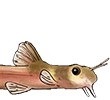https://doi.org/10.1007/s10641-023-01416-y
https://link.springer.com/article/10.10 ... 23-01416-y
Keywords: Environmental impact, Freshwater, Loricariidae, Movement ecology, Road ecologyCrossings between roads and streams can negatively affect fish, especially when culverts prevent free movement along the stream. Understanding this effect is essential to design structures that can mitigate the impact of roads on fishes. Here, we used a capture-recapture study and multi-state open population models to investigate the influence of a culvert on the movement probability of the armored catfish , a small benthic species (maximum total body length ca. 190 mm) endemic to streams in southern Brazil. Additionally, we tested whether environmental variables and body size affect movement probability through the culvert. Fish sampling and environmental data collection were carried out during 2016 and 2017, both in a stream section crossed by a road and in the adjacent free-flowing stream sections upstream and downstream. Movement probability was higher within free stream sections than through the culvert. Water depth in the culvert positively influenced movement probability, whereas body size was not related to movement through the road-stream crossing. Our results indicate that the culvert hinders free movement of R. aequalicuspis and that approximately 30 cm of water depth inside the culvert results in an eightfold increase in passage probability. These results extend the evidence that culverts affect fish movement in streams, even for non-migratory, relatively small species adapted to environments with natural obstacles. This indicates the need to design road-stream crossings that are more favorable to fish movement, especially in streams crossed by roads at multiple sites.





